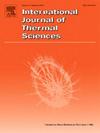考虑界面热阻的层状各向异性土壤中能量桩的解析传热模型
IF 5
2区 工程技术
Q1 ENGINEERING, MECHANICAL
International Journal of Thermal Sciences
Pub Date : 2025-07-01
DOI:10.1016/j.ijthermalsci.2025.110115
引用次数: 0
摘要
能源桩作为一种将地源热泵技术与桩基础结构相结合的创新可再生能源系统,其热性能受复杂土壤条件的影响较大。为了解决天然土壤的层状特性及其交叉各向异性引起的传热机制的复杂性,本研究在考虑界面热阻的情况下,建立了嵌入层状和交叉各向异性土壤中的能量桩的传热模型。利用有限汉克尔变换和拉普拉斯变换,导出了系统在拉普拉斯域中的半解析解,并利用Crump数值反演方法得到了系统在时域内的温度响应。与COMSOL数值解、经典解析解和实验数据的对比验证表明,该模型的温度预测误差相对于数值解保持在2.1%以下。与实验测量结果相比,与传统的各向同性模型相比,均方根误差(RMSE)降低了42%以上。近场温度响应分析表明,土体水平和垂直导热系数对温度分布的影响有明显差异,其中桩体水平导热系数对土体温度响应的影响更大。使用等效的平均热导率会导致温度预测的偏差。参数化研究表明,土壤水平和垂直导热系数的变化对温度有不同的影响。此外,热各向异性比(TAR)和层间导热比(ITCR)对界面温度跳变有显著影响。此外,在不同的导热系数条件下,热各向异性比的变化对温度跳变的影响也有所不同。本文章由计算机程序翻译,如有差异,请以英文原文为准。
Analytical heat transfer model of energy piles in layered and anisotropic soils considering interfacial thermal resistance
The energy pile, as an innovative renewable energy system integrating ground source heat pump technology with pile foundation structures, exhibits thermal performance that is significantly influenced by complex soil conditions. To address the complications in heat transfer mechanisms caused by the layered characteristics of natural soils and their cross-anisotropy, this study develops a heat transfer model for energy piles embedded in layered and cross-anisotropic soils while accounting for interfacial thermal resistance. A semi-analytical solution in the Laplace domain is derived using the finite Hankel transform and Laplace transform, and the temperature response in the time domain is obtained via the Crump numerical inversion method. Comparative validation against COMSOL numerical solutions, classical analytical solutions, and experimental data demonstrates that the temperature prediction error of the proposed model remains below 2.1 % relative to numerical solutions. Compared to experimental measurements, the root-mean-square error (RMSE) is reduced by more than 42 % compared to conventional isotropic models. The near-field temperature response analysis reveals that the horizontal and vertical thermal conductivities of the soil exhibit distinctly different influences on the temperature distribution, with the horizontal thermal conductivity of the pile body playing a more dominant role in soil temperature response. Using an equivalent average thermal conductivity leads to deviations in temperature predictions. Parametric study indicates that the variations in the horizontal and vertical thermal conductivity of the soil have different impacts on temperature. In addition, the thermal anisotropy ratio (TAR) and interlayer thermal conductivity ratio (ITCR) significantly influence the interfacial temperature jump. Furthermore, under different thermal conductivity conditions, the effect of changes in the thermal anisotropy ratio on the temperature jump also varies.
求助全文
通过发布文献求助,成功后即可免费获取论文全文。
去求助
来源期刊

International Journal of Thermal Sciences
工程技术-工程:机械
CiteScore
8.10
自引率
11.10%
发文量
531
审稿时长
55 days
期刊介绍:
The International Journal of Thermal Sciences is a journal devoted to the publication of fundamental studies on the physics of transfer processes in general, with an emphasis on thermal aspects and also applied research on various processes, energy systems and the environment. Articles are published in English and French, and are subject to peer review.
The fundamental subjects considered within the scope of the journal are:
* Heat and relevant mass transfer at all scales (nano, micro and macro) and in all types of material (heterogeneous, composites, biological,...) and fluid flow
* Forced, natural or mixed convection in reactive or non-reactive media
* Single or multi–phase fluid flow with or without phase change
* Near–and far–field radiative heat transfer
* Combined modes of heat transfer in complex systems (for example, plasmas, biological, geological,...)
* Multiscale modelling
The applied research topics include:
* Heat exchangers, heat pipes, cooling processes
* Transport phenomena taking place in industrial processes (chemical, food and agricultural, metallurgical, space and aeronautical, automobile industries)
* Nano–and micro–technology for energy, space, biosystems and devices
* Heat transport analysis in advanced systems
* Impact of energy–related processes on environment, and emerging energy systems
The study of thermophysical properties of materials and fluids, thermal measurement techniques, inverse methods, and the developments of experimental methods are within the scope of the International Journal of Thermal Sciences which also covers the modelling, and numerical methods applied to thermal transfer.
 求助内容:
求助内容: 应助结果提醒方式:
应助结果提醒方式:


